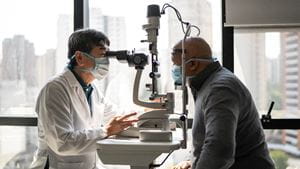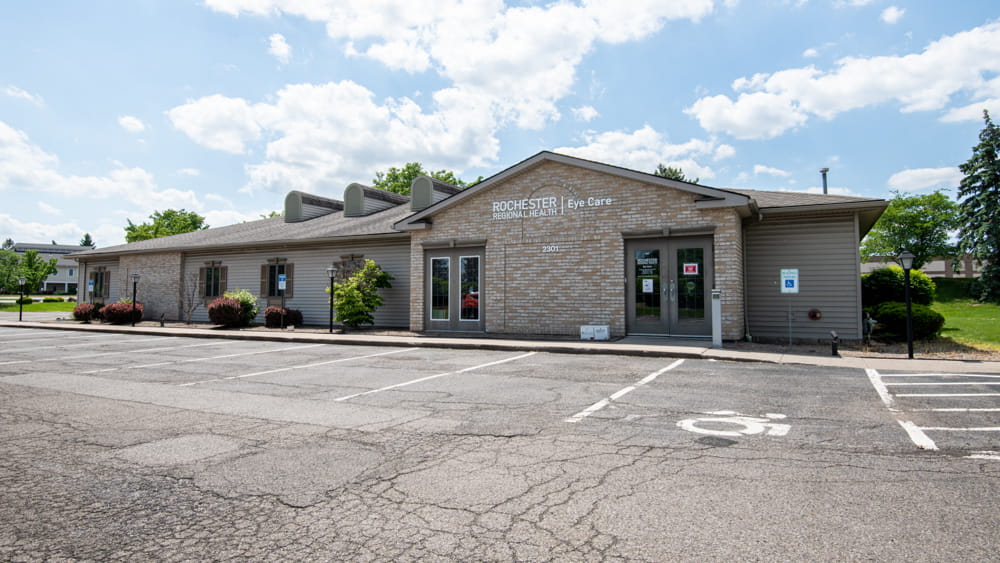
Having dry eye is a common issue for many people – from adolescents to older adults. The inability to produce enough tears to keep your eyes moist can lead to the possibility of more foreign substances in the eyes, which can also increase the risk of an infection.
Rebecca Nally, OD, is an optometrist with Rochester Regional Health Eye Care who treats dry eye in many patients. She describes the symptoms of dry eye, how it is diagnosed, and the treatments available.
Dry eye is an imbalance of tears in the eyes which can lead to changes in vision and visual discomfort.
There can be a few different causes of this imbalance. Some people’s eyes may not produce enough tears. Other people’s eyes may not produce good-quality tears, so the tears are unstable when they come out of the tear duct and onto the eyes.
Tears themselves are made up of three layers: an oily (lipid) layer on the outside, a watery (aqueous) layer in the middle, and a small layer of mucus (mucin) on the inside. With dry eye, the lipid layer on the outside of a tear will evaporate – causing symptoms to develop.
People who are dealing with symptoms of dry eye may have:
Optometrists will try to rule out any sort of infection or inflammation that requires more immediate attention. Allergies often cause an itchy feeling, as opposed to a burning feeling. Eye care providers may suggest or prescribe allergy eye drops in some cases.
For a long time, providers thought older people were more at risk for dry eye, especially women over the age of 50. Over the last 20 years, this group has begun to shift with the ubiquity of smartphones and computer usage.
With the prevalence of smartphones, adolescent and young adult patients are beginning to raise concerns with their providers at eye exams – saying they have symptoms such as blurred vision, burning, or irritation. Patients who use computers at their jobs all day may have a higher risk, as well.
To determine if a patient suffers from dry eye, they are given a thorough dry eye evaluation. This involves a series of diagnostic tests to see:
A tear osmolarity test will check the salt content of a patient’s tears. The higher the salt content, the more imbalanced the tear film is – which can lead to dry eye.
Optometrists may also take photos of the oil glands in a patient’s upper and lower eyelids to determine if they are clogged.
“Every time you blink, the glands secrete oil that mixes with the tears to prevent evaporation. The less you blink, which can happen while working on a computer, the more the oil sits in the glands and begins to thicken,” Dr. Nally said. “This can eventually lead to the glands becoming clogged. When you do blink, the oil is too thick to be secreted and that can lead to tear evaporation and dry eye symptoms.”
The inflammatory test analyzes a collection of a patient’s tears, looking for a protein marker called MMP9. If the marker is present, it can signal inflammation – sometimes even before optometrists can see it themselves.
Taking steps to prevent dry eye is simple and straightforward. Dr. Nally encourages patients who are on their smartphones or working at computers frequently to keep a bottle of artificial tears nearby and put drops in their eyes one to two times a day as needed.
Another method to help prevent dry eye involves using a warm compress or eye mask to keep the oil glands open. These masks can be put into a microwave to warm up, then placed over the eyes for about eight to ten minutes.
“I recommend the Bruder Moist Heat Eye Compress, which is the gold standard of eye masks,” Dr. Nally said. “It contains patented Medi-beads that, when heated, deliver a moist heat that will penetrate the eyelids and keep the oil thin and flowing.”
There are several methods of treating dry eye – most of which are simple and easy to access.
Optometrists will generally suggest over-the-counter treatments to start, such as artificial tears or ointments. There are also eyelid scrubs and sprays that help to reduce bacteria from gathering on the eyelids or eyelashes.
More advanced treatments are available, such as prescription medications that reduce inflammation or in-office treatments that help to increase oil secretion of the glands in the eyelids.
“Taking the time to have a conversation with patients about various treatment techniques for dry eyes often puts them at ease,” Dr. Nally said. “I enjoy giving them the best care that I can, answering their questions, and helping them with any problems. I love developing good relationships with people; it is what I enjoy most about my job.”
